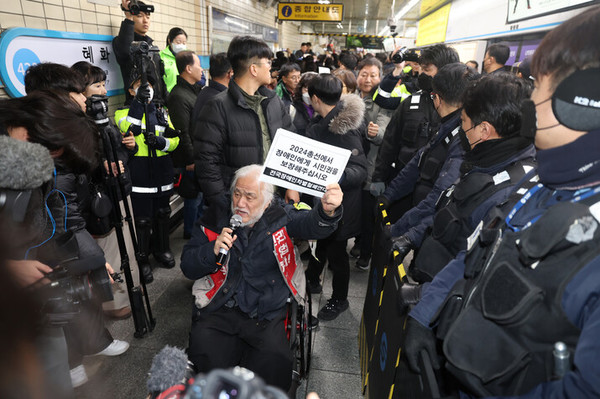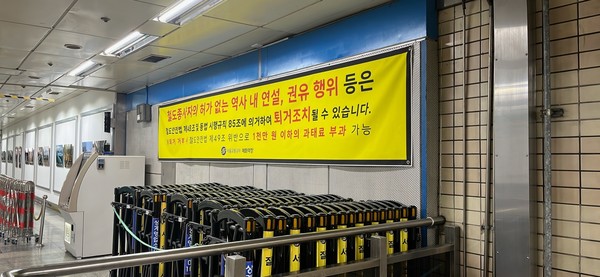
If you are a subway commuter, you may have likely heard at least once about the Solidarity Against Disability Discrimination (SADD), also known as ‘Jeonjangyeon,’ conducting protests in the subway. These protests sometimes result in delays in subway operations or trains bypassing specific stations. There are diverse opinions regarding their protests, with some viewing them as a legitimate assertion of the right to mobility, and others considering them unlawful activities. Let's focus on the stories of those participating in the protests as they emerge from subway stations and the conflicts surrounding these actions.
Why Are the Disabled Individuals Heading to the Subway Stations?
The Solidarity Against Disability Discrimination (SADD) is an organization formed to create a society where people with and without disabilities can enjoy equal rights and comfortably live together. Their subway protests advocate for an environment where people with disabilities can use public transportation, such as buses and subways, to carry out daily activities just like those without disabilities. They emphasize the need to ensure the right to mobility for people with disabilities and call for securing a budget for disability rights, enacting laws related to disability rights, and improving the facilities within subway stations.
There are two main reasons why they specifically hold protests in the subway. Firstly, subways are a primary means of transportation for disabled people. They prefer taking the subway because of its features, punctuality, and being able to do so without assistance. SADD argues that, given the significant number of the disabled using the subway, it is essential to ensure that they are safe. Secondly, their protests are influenced by past incidents, such as those involving wheelchair lifts. In the past, there were accidents resulting in fatalities when individuals using wheelchair lifts for subway access fell. Tragically, even in April 2022, there were incidents of fatal falls while using subway escalators with wheelchairs. These incidents underscore the lack of guaranteed safety for the disabled during subway travel, motivating SADD’s advocacy efforts.
The subway boarding protests for the advocacy of disabled people’s mobility rights have been ongoing since 2021, taking place in urban railways across the nation. SADD announces the schedule and location of the protests to Seoul Metro in advance, and Seoul Metro publishes the protest schedule on its website to inform citizens. To address the potential risks of accidents due to the overlap of protests and crowded people in rush hour, the police are deployed and control the stations where protests are ongoing by preventing trains from stopping. SADD has not only pointed out the difficulty for people with disabilities to smoothly board trains within subway stations but also highlighted the inadequacies of stations lacking elevators that are needed not only for wheelchair users but also for elderly individuals and those with young children. They have demanded the installation of elevators in stations without them. The advocacy for mobility rights by SADD is, however, not limited to the subway. They also call for the expansion of low-floor bus routes designed to accommodate wheelchair users and an increase in budget for handicapped-accessible facilities. Bus boarding protests have also been conducted. It revealed situations where the disabled cannot board low-floor buses, which are designed and operated for them. This has brought attention to the shortcomings of low-floor buses, prompting SADD to emphasize the need for improvements in their effectiveness.
Rejected SADD’s Demands and Conflicts
A Budget that Does Not Reflect the Demands of SADD
SADD's protests effectively serve as a platform aimed at urging the National Assembly to improve the environment to make the mobility of the disabled equivalent to that of those without disabilities. However, governmental institutions such as the Seoul Metropolitan Government and the National Assembly have not acceded to their demands. In January, SADD stated, "If the increase of 271 billion won in the special transportation budget for the mobility rights of the disabled was approved, we planned to cease the rush-hour protests. However, it was ultimately rejected by the National Assembly." Examining the budget allocated within the Ministry of Land, Infrastructure, and Transport for the convenience of transportation-disadvantaged individuals reveals a decrease in the budget to ensure mobility rights. Superficially, the budget for the enhancement of transportation convenience for transportation-disadvantaged individuals in 2024 increased by 3.5% compared to 2023. Budgets were allocated under categories such as 'Introduction of Special Transportation Assistance,' 'Support for Long-Distance Movement of Transportation-Disadvantaged Individuals,' and 'Establishment of an Integrated Management System for Transportation-Disadvantaged Individuals.' However, the budget introduced for low-floor bus support was reduced by approximately 11.6% compared to 2023, amounting to a drop of around 220 billion won. SADD argues that due to the lack of visible efforts by the government to improve the mobility rights of the disabled, they are compelled to persist in their visible struggle.
Conflicts Between SADD and the Seoul Metropolitan Government

However, the Seoul Metropolitan Government has classified SADD's rights advocacy as ‘illegal protests.’ Citing Article 48 of the Railroad Safety Act[1], Seoul Metro defined SADD's protest as an illegal action. The basis for this decision included allegations under Subparagraphs 6 (making noise, such as using violent language or speaking loudly in railroad infrastructure), 8 (sleeping in station facilities), 9 (hindering the operation of a train by getting on or off a moving train or obstructing the opening or closing of entrance doors), and 11 (attaching and distributing advertisements within the station). Furthermore, invoking Article 50 of the Railroad Safety Act, Seoul Metro argued that SADD, engaging in prohibited activities, should be subject to eviction measures.
In practice, SADD representatives conducting protests within subway stations, monitored by police personnel stationed there, have been arrested on charges of current offenses. In January 2024, Lee Hyeong-suk is a co-representative of the Seoul Solidarity Against Disability Discrimination. He participated in a protest at Hyehwa Station, expressing opposition to the Seoul city's reduction in the budget for tailored public jobs for severely disabled individuals and 400 fired workers. Despite repeated police requests to vacate, the group members did not comply. In response, the police arrested Lee Hyeong-suk on charges of non-compliance with eviction, obstruction of duty, and violations of the Railroad Safety Act. On that day, following the arrest of Lee Hyeong-suk, 28 individuals associated with SADD were also arrested on charges of non-compliance with eviction. Seoul Mayor Oh Se-hoon, initially taking a passive stance, stated, "If you refrain from staging protests during commute hours, citizens will be more supportive." However, in December 2022, responding to the presidential office's announcement that "SADD will be rigorously dealt with by the law," the subway stations where protests were taking place received directives to cease train operations without stops. During 2023, there was a firm response to SADD's actions, with authorities claiming that SADD's objectives were more about deinstitutionalization[2] than securing mobility rights. This rationale led to the arrests of SADD affiliates as current offenders.
Citizen’s Mixed Reaction
SADD is expected to continue its subway boarding protests, demanding communication with national institutions, including the Seoul Metropolitan Government. While some citizens support their protests, there is a concurrent view that their actions are excessively disruptive and need to be curtailed, considering the prolonged inconveniences endured by citizens over the past four years. Concerns have been raised about the practical disadvantages on non-protesting citizens, such as delays in attending school classes or work, due to SADD's protests. Nevertheless, incidents of violence during the suppression of protests have prompted discussions about government responsibility for violence, separate from illegal acts associated with the protests. Some people consider it an administrative duty to curb the radical nature of SADD's actions, while others critique it for potentially infringing on the mobility rights of the disabled and silencing the voices of minorities.
CAH gathered opinions from students at Chung-Ang University regarding SADD’s subway boarding protests.
Student A from Department of Sociology: "I have been interested in the issue of mobility rights for the disabled, so I am well aware of how they have been oppressed in the right of mobility movement. Therefore, knowing their efforts, I am infuriated by the portrayal of SADD’s subway protest as a group taking away the rights and time of others just to personally benefit. It is particularly uncomfortable to see it being used as an image of hatred. SADD's actions are a natural 'struggle for rights'. Simply boarding the subway in a wheelchair becomes a protest, and if it causes delays, it signifies that the mobility rights of wheelchair users are not being properly ensured. In fact, I do not see this situation as a conflict but rather as the reality of people with disabilities being recognized the same as other people. To guarantee the mobility rights of the disabled, the government should strive to ensure the basic livelihoods of all citizens, including people with disabilities."
Student B from Department of Political Science and International Relations: "While I have not directly suffered from SADD’s subway protests, I have heard stories of others being late for classes and missing out on lesson content. I understand their protests as demands to the government to ensure the mobility rights of the disabled, as part of the deinstitutionalization and human rights movements. I understand that the demands they ask to the government and the Seoul Metropolitan Government have not been met, leading to their decision to protest. However, while I sympathize with their protest purposes, I think the method of subway boarding protests is inappropriate. The situation is serious in that the manner of expression takes other citizens' mobility rights as hostage, rather than being confined to a demonstration. While consideration should be given to people with disabilities, they should be ensured equal rights as ordinary citizens, without exceeding them."
Student C from Department of English Language & Literature: "I have been late for work due to subway delays caused by SADD’s protests. Experiencing inconvenience directly caused by protests left me feeling extremely frustrated and perplexed. Consequently, I view protests very negatively and as inappropriate behavior. I find it hard to understand why SADD insists on conducting protests specifically at train entry points when there are other locations such as subway gates or screen doors where protests could take place. The method of inconveniencing many citizens is flawed and incomprehensible to me. Moreover, it seems that elevators are installed at most stations, and there the minimal inconvenience is experienced due to the gap between trains and platforms. Therefore, I believe that rather than protesting in this manner to protect the mobility rights of the disabled, we should increase the availability of taxis for people with disabilities. However, it is important not to hold biases against people with disabilities, and I believe we should assist and be considerate towards individuals with disabilities who are using the subway."
Opinions on whether the protests by SADD constitute a struggle for securing mobility rights or disruptive actions causing inconvenience to citizens are divided. Moreover, it is challenging to definitively determine whether these actions can or should be considered illegal. However, what can be gleaned from their outcry is the difficulty people with disabilities face in using public transportation on par with the able-bodied. It is hoped that swift measures will be taken to allow individuals with mobility challenges to use public transportation just like everyone else, fostering a harmonious society in Korea.
[1] It is for conducting prohibited for protection of railroads and maintenance of order.
[2] Deinstitutionalization is the process of transitioning individuals from long-term institutional care, such as psychiatric hospitals, to community-based settings, aiming to promote independence and normalize living experiences.

